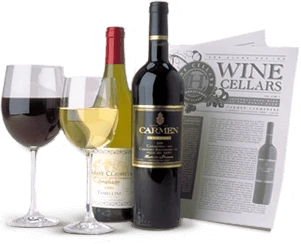At last, a Malbec with charm, personality, and style along with the usual Malbec might. Make no mistake about it; the 2003 Salentein Malbec has plenty of up front flavor and grip, but it, also, possesses Bordeaux like finesse. Deep, dark, and foreboding in color, one could easily mistake the 2003 Salentein Malbec for just another well made tannic Malbec – at first glance. However, the 2003 Salentein Malbec is worth more than a mere second look. In fact, this wine is more than good; it’s Malbec at its best. As one panel member so aptly stated: “The 2003 Salentein Malbec is rich, ripe, and assertive but also well mannered.” Indeed, fourteen months in French oak barrels have lent a Rioja like nose of sweet oak and subtle nutlike aromas to this wine, which complement the smooth ripe blackcurrant and plum fruit that saturate its center. On the finish, soft well integrated tannins lend zip and the promise of even better things to come with bottle age, but with nary a searing bite or even a trace of hardness. Kudos to the folks at Salentein for a noble effort! For optimal enjoyment, we suggest decanting the 2003 Salentein Malbec for an hour before consuming it or better still give it just five minutes on Vinatron’s Accella Breathe and enjoy!
As at home at an elegant dinner party as it is at a barbecue, the 2003 Salentein Malbec shines at the table in a multitude of settings. Whether the evening fare is Châteaubriand or Bacon and Cheddar Cheese Burgers Salentein’s 2003 Malbec provides good company. Also, we recommend grilled Italian sausages, either the cheese, fennel, or moderately hot versions, with a glass or two of this Malbec. And if you want to perk up a mid week meal, serve the sausages over creamy polenta or grits. Lamb Stew and Grilled Lamb Kebobs with roasted peppers, onions and root vegetables do justice to this wine as well. Last but by no means least, Eggplant Rollini and Zuccchini Parmigiana offer excellent accompaniments, too. Buon Appetito or should we say Buen Provecho!
Bodegas Salentein shares a rich history that parallels the settlement of Argentina by Spanish and Italian immigrants. By the 17th century, Salentein was part of an estancia called De Arriba that belonged to the Jesuits, who were the first to successfully cultivate the vine in Mendoza. The ruins of the original Jesuit farmhouse called Casa Grande are still part of Salentein’s property. They lay surrounded by a grove of trees that were planted by the early missionaries, at nearly 5,000 feet upon sea level.
Salentein is a well endowed, privately held estate whose wines are as impressive as its modern winery. In addition to employing Michel Rolland, France’s most sought after enologist; Salentein occupies a prime location in the foothills of the towering Andes. Its vines soar to 5,600 feet, which makes them some of the loftiest vineyards in the world, The winery itself is built in a shape of a cross and is surrounded by the estate’s four fincas or properties. Each of the four wings of the winery contains its own small winery with two distinct sections: the first at ground level houses stainless steel tanks, while the second lies 8 meters underground and is used for maturing the estate’s wine in oak casks. The four wineries meet in a central chamber that resembles an amphitheater where they share a common bottling facility. Pretty smart thinking we would say.
Bodegas Salentein specializes in the cultivation and production of Cabernet Sauvignon, Pinot Noir, and Malbec – Argentina’s specialty. Unlike most other Argentine wineries, Salentein is devoted entirely to premium production, which is evident in the estate’s wines.
Los Andes
The Andes are the tallest mountains in the Western Hemisphere, dwarfing the Rockies and the Sierras with their sheer magnitude. However, the Andes are more than a geologic mass, they are a mystical experience. They cast their shadows and mysteries upon the present day population of South America as they did the ancient Pre-Columbian peoples who inhabited their lower reaches.
Without the towering Andes, there would be no cultivation of the vine in Mendoza and no real agriculture as we know it, nor would viticulture thrive in the river valleys of central Chile, which lie just across the Andean spine or Cordillera from Mendoza – a mere one hundred miles as the condor flies, but still a torturous eight hour adventure by car. Simply, it is the Andes that give life to the desert like Mendoza and the arid rift valleys of Chile. Specifically, it is Andean snows that accumulate upon the higher elevations of the Andes that give life and sustenance to these parched parcels of South America that yield the continent’s finest wines.
In order to make the desert bloom, the inhabitants of the Andes have come to rely on their mighty mountains for water. By sluicing off the Andean snow melt and directing its waters into canals, much of Argentina and Chile are now productive farmland and especially suited to the cultivation of the vine. Since the Italian migration to Argentina in the 19th century and subsequent settlement in the Illinois size province of Mendoza, the Mighty Mendoza has become the largest wine producing area in South America, leading Argentina to fifth among the world’s leading wine producing nations just behind the United States. Without the Andes, there would be no wine or much else to speak of from Mendoza. Viva Los Andes!

Enjoy Limited Production Estate
Bottled Wines
Discover limited production estate bottled wines such as Vergenoegd's internationally
acclaimed 2005 Cabernet Sauvignon, imported exclusively for our members.

